Imagine exploring three of the worlds most dynamic and fast paced cities from the comfort and convenience of a private jet. Imperial Tours has partnered with Peninsula Hotels, renowned for flawless service and quality, to provide you with the ultimate China experience, Peninsula Hotels’ Private Jet Tours. We have crafted three themed itineraries – Culinary, Family and Culture & Heritage – each designed with immersive experiences to captivate you while introducing the rich culture, cuisine and history of China.

Experience a journey like no other on a Peninsula Private Jet Holiday
For many people, the thought of visiting China sparks a sense of wonder and excitement for the mysterious culture of the East. As one of the most populated and diverse countries in the world, China provides a cornucopia of experiences engaging all the senses. While this temptation to discover the East is an enticing lure it can also be overshadowed by fear of the unfamiliar. With Peninsula Hotels’ Private Jet Tour itineraries you will experience the reassuring comforts, anticipatory service, and soothing attention to detail of legendary hotelier, Peninsula Hotels. In this way, the exoticism and mystery of the East can be enjoyed from the reassuring platform of some of the world’s leading hotels.
Each tour provides access to one-of-a-kind bespoke experiences only available as a result of the partnership between Imperial Tours and Peninsula Hotels. For example, you will explore a seafood bazaar in Hong Kong with the Executive Chef of the Peninsula Hong Kong and learn to paint with the Peninsula Beijing’s resident artist. Alternatively, try climbing aboard Peninsula Shanghai’s private yacht for an architecture tour of its future cityscape from the Yangzi River. Each itinerary features unique hotel experiences in China born of the collaboration between Peninsula Hotels and Imperial Tours.

Private access to world renowned cultural sites is merely a starting point for our Culture & Heritage tour. Apart from meeting with some of the most influential leaders in China’s arts and culture sector, you will also view rare art collections normally closed to the public. For instance, you will tour meet and enjoy lunch with the founders of China’s leading home-grown auction house and also tour private galleries in Beijing and Shanghai with gallery owners. In Beijing, you will not only enjoy a private lunch al fresco on the Great Wall of China but also meet with the conservationist responsible for the law protecting it.
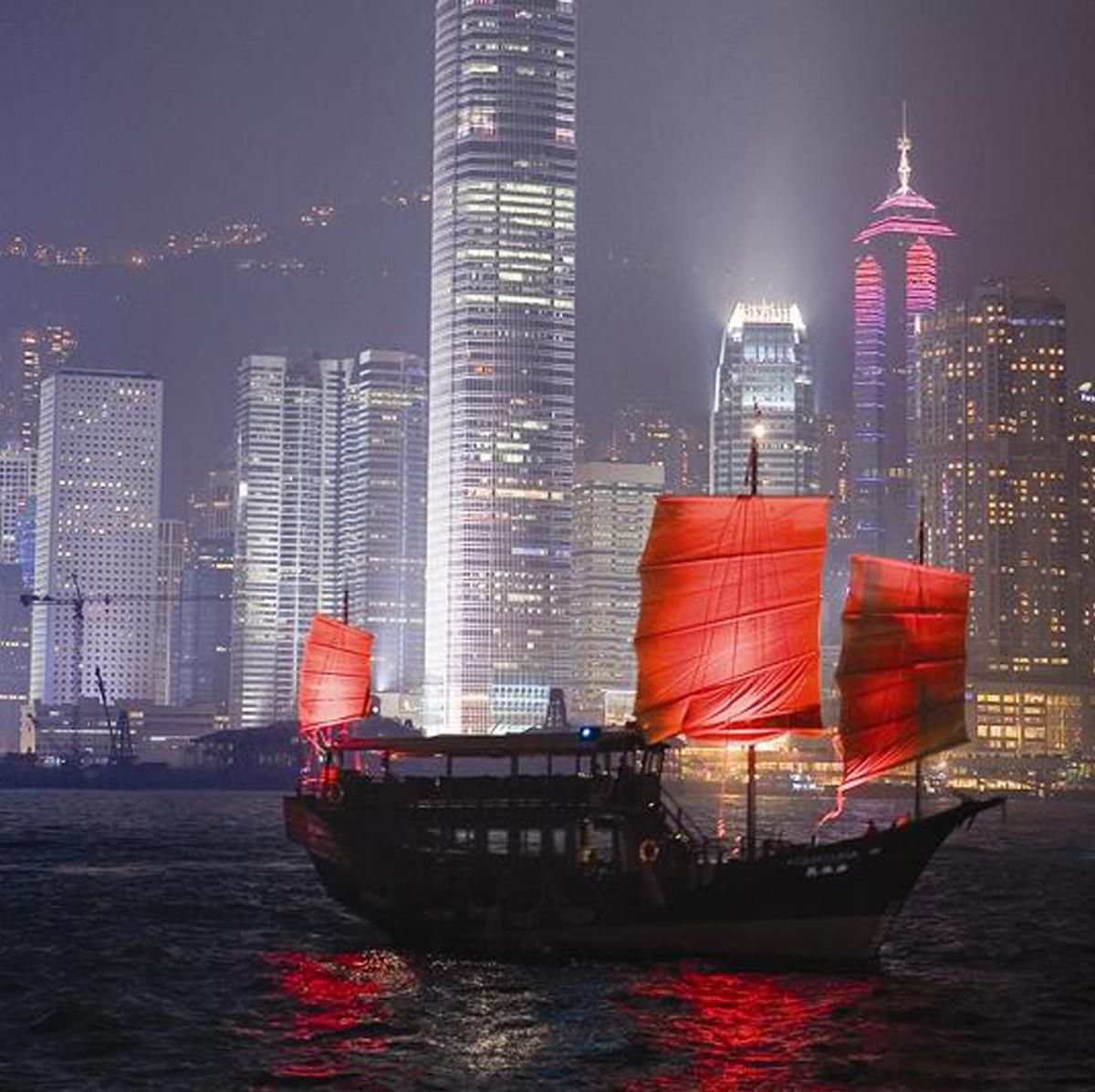
Culture & Heritage Tour, uncover the mysteries of the east from the comfort you can only experience with Peninsula Private Jet Tours
A family vacation by private jet not only eases the stresses of traveling with a family; it also provides a relaxing environment to connect and spend quality time together between destinations. Enjoy the ultimate family vacation in China with experiences ranging from a Chinese cooking lesson with a Peninsula Chef to painting lessons with the resident artist in Beijing’s Peninsula property to playing table tennis with a former Chinese Olympian. Other highlights on our Family Tour include, hand-feeding pandas and enjoying VIP access to the newly opened Shanghai Disney. We have curated only the best experiences to ensure that each member of the family is captivated and entertained, providing you with a relaxing, memorable and safe vacation abroad. Make your next family vacation one filled with unforgettable experiences sure to entertain, bring you closer together as a family and introduce your children to the magnificence of China.
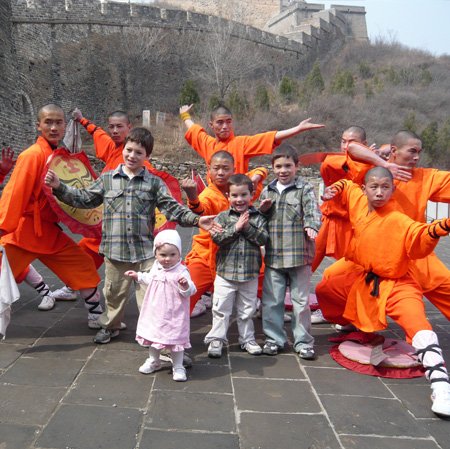
Family Tour, give your family an experience they will never forget from the safety and comfort of a Peninsula Private Jet Tour
China is a “must-eat” destination for foodies everywhere and our Culinary Voyage private jet tour offers the best China has to offer. Given our destinations of Beijing, Shanghai and Hong Kong, we focus on three main schools of cuisine; Imperial, Huaiyang and Cantonese from the perspective both of fine dining and home-style cooking. Together with Peninsula Hotels we have created a tour that provides exclusive access to Peninsula’s private kitchens as well as opportunities to learn, shop and cook with the best. For example, the Executive Chef of the Hong Kong Peninsula accompanies you on a traditional junk to his favorite island seafood bazaar. Alternatively, a TCM qualified nutritionist introduces you to China’s leading farm to table organic restaurant specializing in traditional cooking techniques. You will be introduced by experts to the art of preparing and cooking some of China’s most famous dishes from Peking duck in one of Beijing’s top duck restaurants to hand thrown noodles and dim sum. No matter your palette, our culinary tour will leave you with a newfound appreciation for the range and art of Chinese cooking.
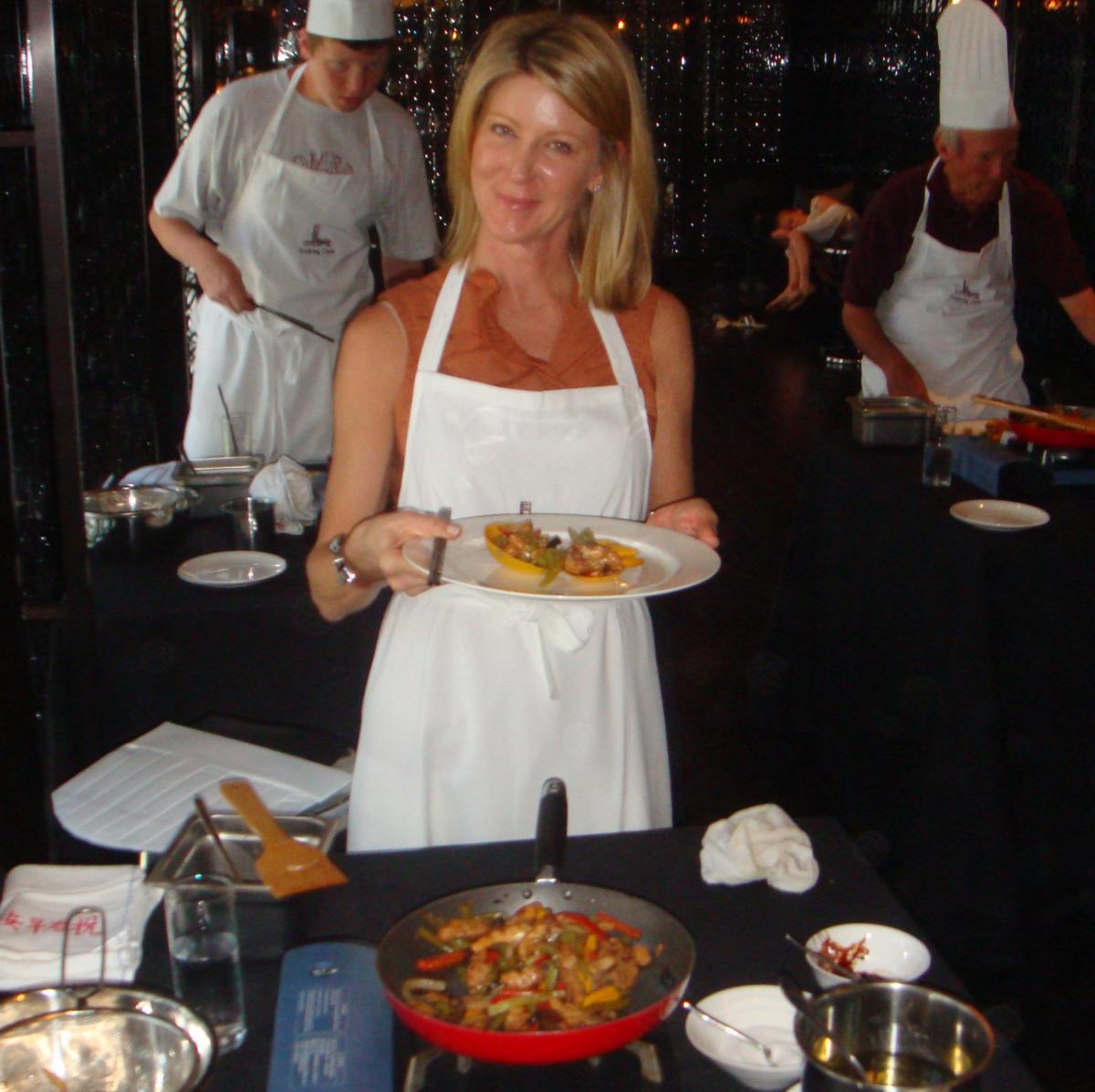
Culinary Voyage, learn the art of creating some of the most iconic dishes in Asia with Peninsula Hotels & Imperial Tours
Flying on a private jet not only enhances your comfort, it also allows you to see and do more in a shorter amount of time. These itineraries are so enriched with eye-opening activities and unusual experiences that you will be captivated from beginning to end.
Please join these scheduled departures, if you can. However, if are not able to make those departures but wish to take advantage of these itineraries, please do enquire. Not only can we supply various sized planes according to group, but we can tailor itineraries to visit other destinations. For example, a Culture and Heritage group might wish to add Hangzhou or Dunhuang, a family might be interested in Guilin and a culinary group might want to check out Chengdu to find our more about Sichuanese cuisine. Additionally, each itinerary is adaptable to include commerical flights instead of flying via private jet.
No matter what you wish to see and do in China, Imperial Tours together with Peninsula Hotels will endeavor to make your dream vacation a reality. Consider China a world undiscovered, a place rooted in an ancient history with a trajectory leaping into the future. Let Imperial Tours together with Peninsula Hotels help you uncover the mysteries of the East from the luxury, security and comfort of a private jet tour.
By April 2017, the Peninsula Palace Hotel will have completed its US$123 million extensive renovation of what was already one of the best known luxury hotel properties in Beijing. If the early 1990’s white-tiled, pavilion-roofed building (a classified heritage property) revealed China’s attempt to qualify western-defined modernity with Chinese characteristics, then the new renovation combining classical Imperial themes and the best contemporary art within an ultra-luxury context is more than a simple coming of age. With super-sized, beautifully detailed guest rooms, a new check-in approach and its own art gallery, the Peninsula Palace Hotel hints at China determining its own path to the future.
When the Palace Hotel first opened its doors in 1989, it introduced the first luxury shopping mall to Beijing. More than a symbol for statesman Deng Xiaoping’s famous aphorism “to get rich is glorious”, it became the venue for the newly wealthy to realize their early consumerist fantasies. Since 1990, the year Peninsula Hotels took up management, the Palace Hotel has been THE hotel for Beijing’s cognoscenti and elite.
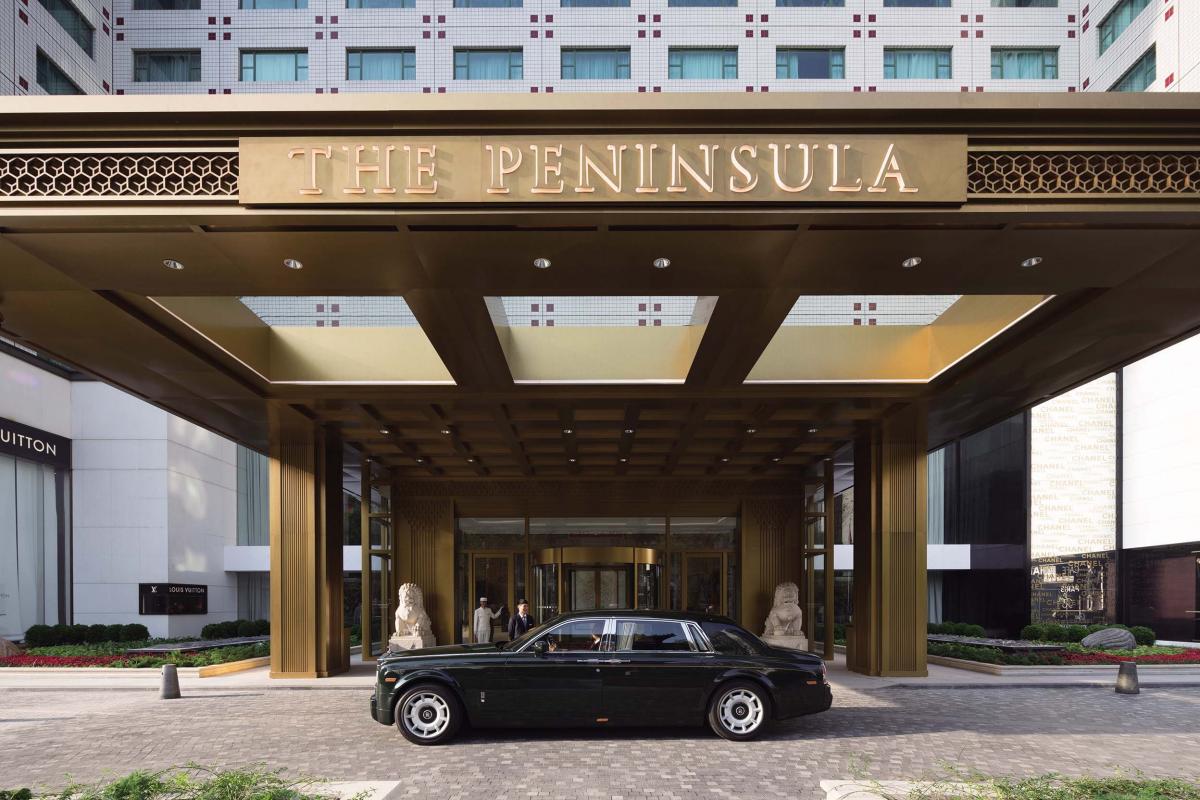
Welcome to the newly renovated Beijing Peninsula Hotel
Besides a US$27 million refurbishment in 2002 that focused on the Presidential Suite, club floor and the two restaurants, Chinese and Western, little had changed between 1989 and 2012. When Joseph Sampermans, previously Hotel Manager at the sister Hong Kong property, was appointed to be GM and tasked with the project of renovating this Grande Dame, plans for making the premier hotel in Northern Asia commenced. “How do you think it should be?’ he asked Nancy and myself at an early meeting. “Like a Peninsula,” we rejoined.
In the same property that previously had served 525 guest rooms, from April 2017 when all the rooms will be returned, there will only be 230. Even though the hotel insists these 230 are mostly “rooms”, let me share a secret with you. They’re not. Each room, with a standard area of 650 square feet or 65 square meters is actually a suite offering a separate bedroom, bathroom, dressing room, and a sitting room. Which begs the question: if the rooms are already suites, then what are the suites? Large would be the apposite description – whereas, broadly speaking, two former rooms were combined to create a new room, at least three former rooms have been combined to create the newly styled suites. And with 61 suites out of 230 keys, this hotel is luxuriously equipped. If you bear in mind Peninsula and Joseph’s bold ambition to create the finest hotel in northern Asia, the grandiose use of space makes sense.
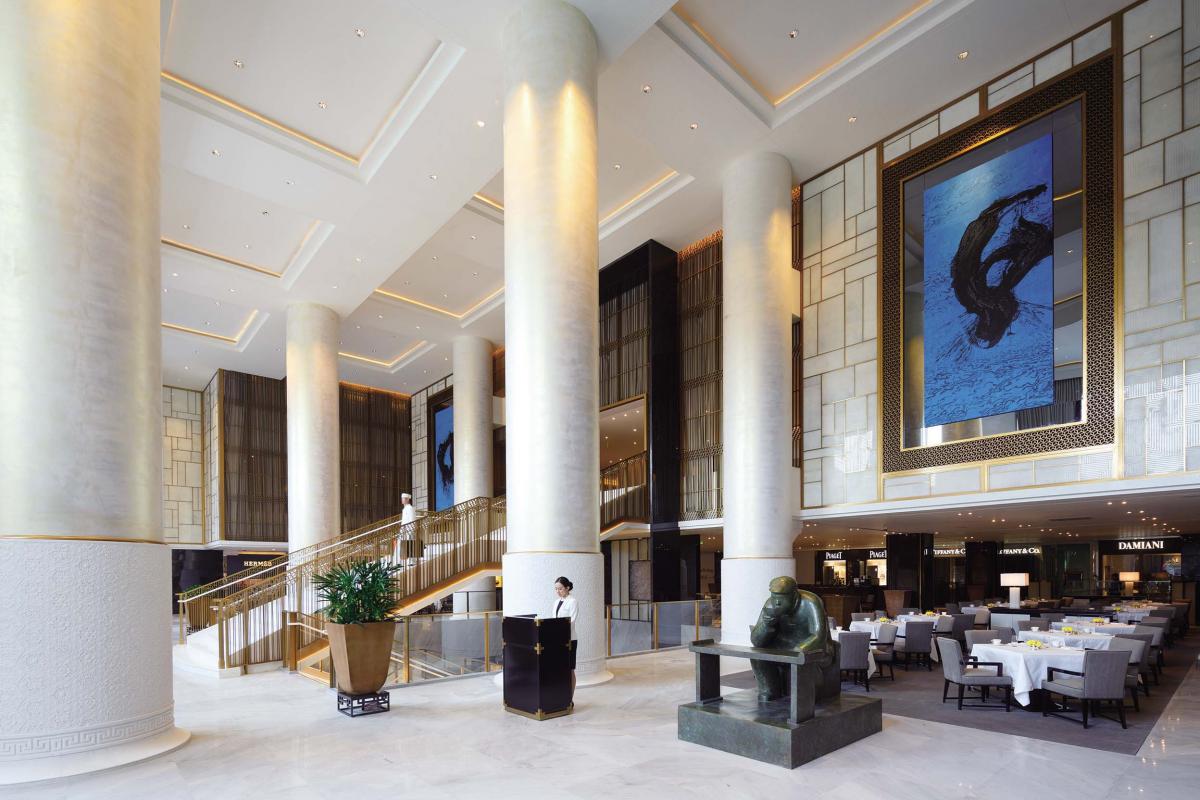
Newly redesigned lobby featuring Zhang Du bronze sculptures
Apart from the handsome renovation of all the surrounding retail areas, there have been three main changes in the lobby. Most importantly, seating for a new dining area has been brought to the fore behind the beautiful over-sized Zhang Du bronze sculptures. The sight and sounds of a dining crowd personalizes the vast space that this three story lobby encompasses. Structurally, the under-lit staircase has been modernized to lead from the ground floor up to the banquet areas, thereby dividing the space in two between six beautiful new white marble pillars. As a result, banquet and conference guests are neatly guided through the lobby. Room guests, by contrast, are met near the front doors by cross-trained, iPad equipped hotel staff to be whisked to a welcome area, and from there directly to their rooms where check-in takes place.
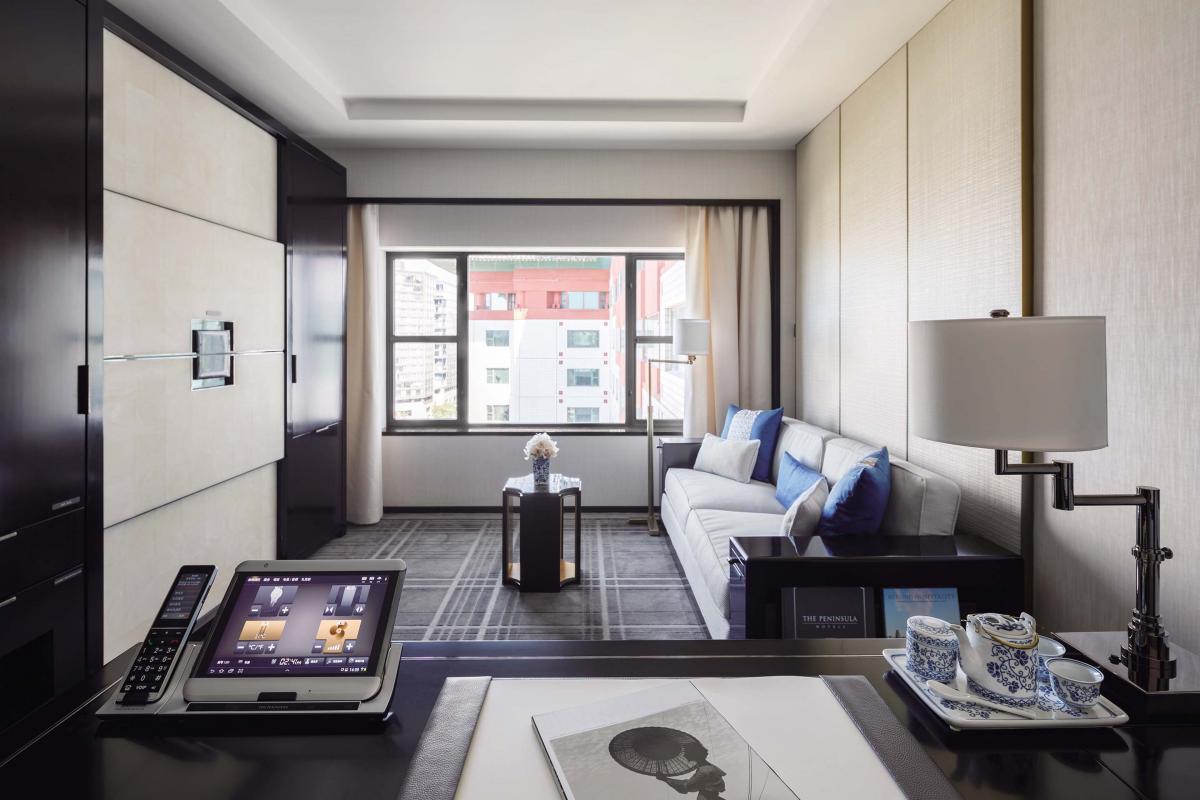
Contemporary living space in the Peninsula Suite
The detailing of the upholstered rooms was a marvel. The leather cladding of the drawers, neatly labelled, makes you think of the upholstery in the Peninsula Rolls Royce. The blue and white couch both complements and contrasts with the muted whites and creams of the room. The richly appointed bathroom, with black marbled floors and white marble walls and a matching abstract ink painting above the bath, is a space that works.
“Intuitive technology” has been a big part of Peninsula’s efforts since the renovation of the Hong Kong Peninsula with which Joseph was also involved. The Beijing Peninsula takes this journey one stage further with the addition of mobile phone ports in both the sitting room and bedroom, which instantly connect your phone with the room’s multimedia system and allow you immediately to watch videos on the LCD Screen and play your music on the stereo without ever having to touch a button. In addition to these new services, Peninsula of course still provides free international VOIP calls from the room telephone. Peninsula’s ambition is not to have gadgetry for its own sake, but to provide room services immediately and intuitively. For instance, I used the hotel room’s iPad to order an iron to my room. To my surprise, it arrived promptly ten minutes later, such that I was able to get ready for dinner.
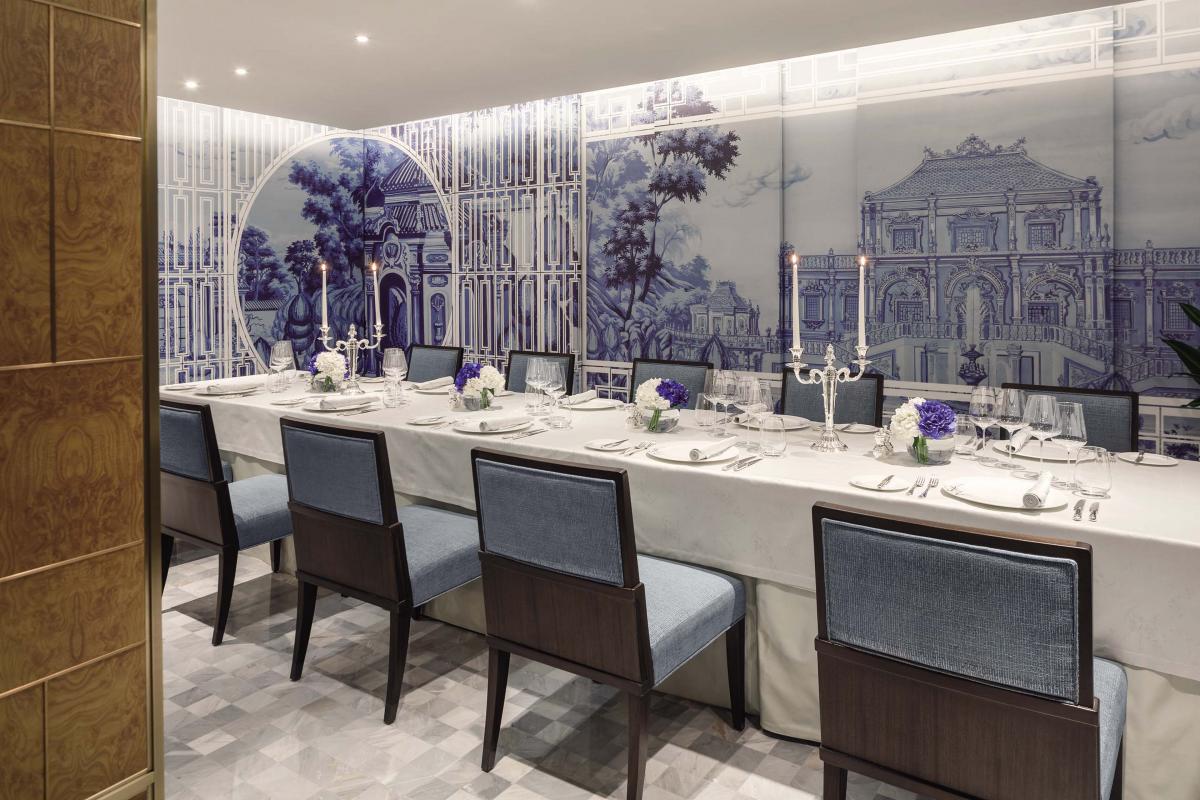
Traditional blue & white ceramics in the Jing Restaurant
Jing, the western restaurant, also got a complete make over to become very much at one with a more sophisticated presentation of Beijing. The long cocktail bar vestibule leads into an elegant room whose walls are adorned with appealing Chinese contemporary art. It is only on a second take that one notices recesses leading to private dining spaces, such that the restaurant is both intimate and capacious at the same time. (The art works are so good, that we ended up touring the entire space as though it were an art gallery). Spanish chef, Alberto Becceril, working with a farm to table concept that prioritizes locally-sourced organic produce, conjures refreshingly innovative and elegant dishes. Becceril’s dishes in no way resemble some kind of dramatic chemistry experiment. Their traditional grounding is as apparent as his artistry in the sophisticated new interpretation and presentation.
This sophistication is a theme that echoes throughout the project. Its contemporary art consistently makes reference to classical or traditional themes or materials. The abstract ink painting in the bathroom reflects the deep tradition of calligraphy. The Zhang Du bronzes remind one of statues typically greeting visitors in traditional tea houses. One of the art pieces in Jing plays with traditional blue and white ceramics; a second displays the traditional skill of embroidery. Similarly, the guest room design combines the classic upholstery one finds in traditional car brands with the latest in-room technology. Everywhere you see a clever interplay between contemporary and traditional design to create an elegant interpretation of the present.
It’s both a thrilling and tough job to be an opening GM, the arbiter of an entirely new hotel project. Joseph was tasked with creating the best hotel in Northern Asia. Has he succeeded? This is a question that only time and you can answer. However, there are two undeniable facts. Firstly, Joseph has helped to create a Peninsula worthy of the name. That’s challenging because of the paradox of ensuring that the property is not formulaic whilst simultaneously adopting elements common to the brand. Secondly, Joseph and Peninsula have given it their all – there has been a massive investment in design, contemporary art, technology, and space harnessed within a sense of style that is the preserve of only a handful of hotel companies. The property does not hedge its bets behind tradition. It extends itself ambitiously to the future, and in so doing it helps define its locale. The China of 2016 is far more self-confident, stylish and global than thirty years ago; it is hardly surprising that the Peninsula expresses this.
Experience the great outdoors of China. Breathe in the crisp clean air and stand in awe over her beauty. While we guarantee your China experience will be one of culture, cuisine, and wonderment, it can also be filled with breath taking scenery and dramatic landscapes. China’s natural landscapes offer experiences for all types of travelers. To help showcase some of China’s outdoor experiences we have compiled in this article the best natural destinations.
So when packing your bags, be sure to include some comfortable shoes, hydration gear, and of course – a camera.
The Great Wall of China
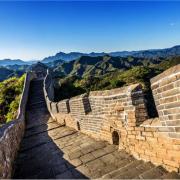
One of the many views on the Great Wall
We have all heard of it, with its impressive 20,000km length, The Great Wall of China is one of the most monumental manmade structures in the world. Built throughout different dynasties, beginning in the 3rd century B.C, the Great Wall was originally built to prevent an invasion from barbarian nomads. Today, the Great Wall of China is one of the most visited attractions in the world. And for nature lovers hoping for a remarkable and less touristic hike, you will be happy to know that the Great Wall has many sections that have been left virtually untouched and tourist free. These ‘off the beaten trail’ areas provide picture perfect wild sceneries, where more adventurous travelers can enjoy breathtaking views of the Great Wall surrounded by nature.
Biking & Hiking in Huangshan
In the Southern area of Anhui Province, just three hours by high-speed train from Shanghai, you will discover the Huangshan Mountain range. The Huangshan Mountain range, featured in the blockbuster movie Avatar, is also frequently referred to as the Yellow Mountains. Huangshan is classified as a UNESCO World Heritage Site famous for its beautiful scenery, breath taking sunrises and sunsets, and of course the almost magical sea of clouds that sweep throughout the mountains. With more than 50km of footpaths and trails, as well as cable cars to help ease tired legs, you can spend the day hiking the various trails and viewing the dramatic scenery. After your day on the mountain, ease your tired legs at the beautiful Banyan Tree located just off the mountain.
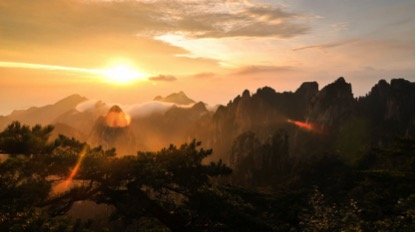
Sunrise from above the clouds in the Yellow Mountains
After your night of relaxation, spend the next day discovering the Ancient Villages of Hongcun and Xidan. Both villages have long history and splendid Anhui Culture as they remain untouched since they were built in the 14th century. Be transported to another era walking through the unique alleyways and ancient buildings, all the while being wrapped in the delicate aroma of hand picked local tea and fresh flowers.
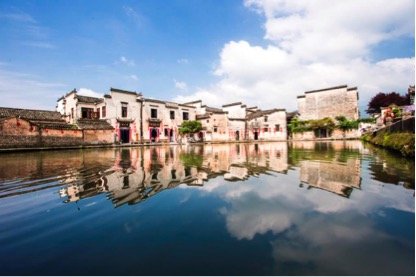
View of the Ancient Village of Hongcun
Guilin & Beyond
Located in the South of China, consider Guilin as your jumping off point to experience some of China’s most beautiful natural environments. There are many unique scenic places located only 2 hours or less from Guilin. However, two of the most beautiful locations, ones that will leave you speechless, are Longsheng and Li River.
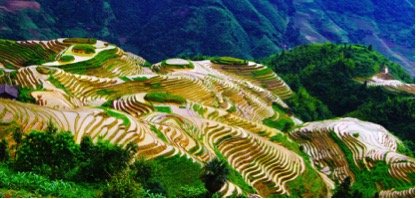
Long Ji Rice Terraced fields
In Longsheng you will find the iconic Long Ji (Dragon’s Backbone) Rice Terraces fields. Featuring more than 66 square km of terraced fields, within mountains 800m above the sea level. If you’re wondering when to visit, the best time of the year to visit the Longsheng fields is May, when irrigation starts, and the fields are filled with water reflecting the image of the sky, creating a unique effect.
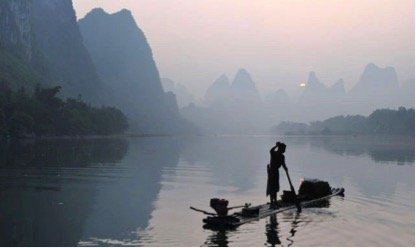
Fisherman on the misty Li River
During your adventure in the Guilin area, you can also experience sailing on the Li River. As you cruise along the river banks you will discover the dramatic landscape of the Li River with its green hills, clear water, peculiar stones, caves, and famous mist that give the river its iconic look.
Hike to Ganden Monastery in Lhasa, Tibet
Only 40km away from the capital city of Tibet, Lhasa, settled on the top of a 4200m-altitude mountain, you will discover Ganden Monastery. In addition to being one of the largest monasteries in Tibet, Ganden Monastery is also one of the 3 Great Temples along with the Sera Monastery, and Drepung Monastery. However, Ganden Monastery is the only monastery of the 3 where you can take inside photos, for a reasonable fee. Despite the beauty of the Monastery, the must-do highlight is to hike around the Monastery. The kora, or holy pilgrimage route around the Ganden monastery, is truly one of the most magical and inspiring places in the world. Not only are the views breathtaking, the experience of prostrating pilgrims and monks walking along with you, is something we cannot begin to put into words.
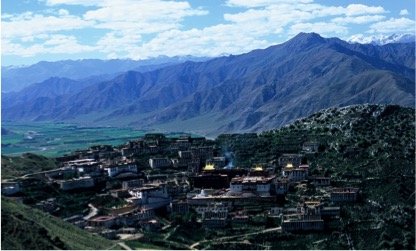
Lhasa Valley & Ganden Monastery
Shangri-La
Formerly known as Zhongdian city, Shangri-La is one of the most beautiful places in China. Described as a mystical and harmonious earthly paradise by British novelist James Hilton, in his 1939 “Lost Horizon” novel, Shangri-la is truly a place of wonderment. Located at the meeting point of the Tibet, Yunnan, and Sichuan provinces, Shangri-La has an eclectic mix of ethnic groups, but is mostly inhabited by Tibetans. Its isolated location 3,000m above the sea level, offers travelers the opportunity to discover and learn from the Tibetan culture and lifestyle, while experiencing the vast natural landscapes of China. Shangri-La is a city surrounded with culture, history, and natural wonders. For the nature loving traveller, Shangri-La is a must.
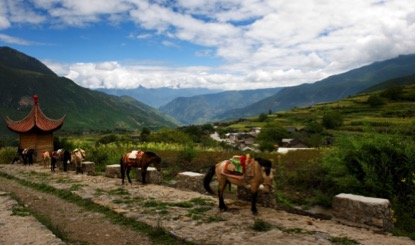
Experience the vast nature of Shangri-La
Hong Kong
While the image of Hong Kong may bring skyscrapers and crowded streets to your mind, what you may not know is that three quarters of Hong Kong’s landscape is countryside and 40% of its territory is protected for nature conservation. So after experiencing one of the most exciting metropolises in the world, escape the streets of Hong Kong and head outside to experience great hikes and outdoor activities for travelers and locals alike.
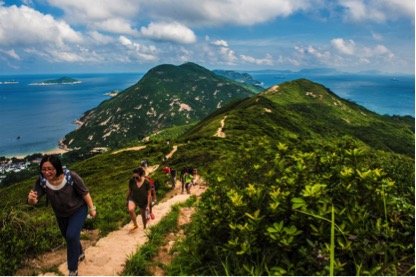
Hiking the Dragon’s Back Trail in Hong Kong
One of the best and most popular hikes in Hong Kong is the 8.5km-long hike along the Dragon’s Back ridge. The name of the ridge comes from the dragon like shape of the path that connects Wan Cham Shan hill and Shek O peak. Gentle slopes will guide you along the trail while you enjoy unbeatable views of the South China Sea and the coastal buildings of Hong Kong Island. When you reach the end of your trek, relax in the sandy and blue sea beaches in Shek O village or Big Wave Bay.
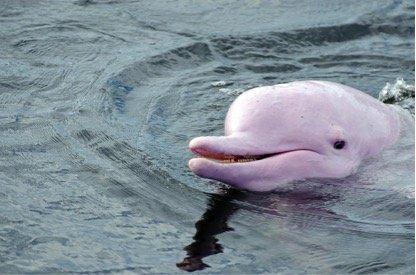
Chinese Pink Dolphin in the waters of Hong Kong
Finally, a must do on your visit to Hong Kong, is to see the famous Pink Dolphins. These unique dolphins are a subspecies of Indo-Pacific dolphins that only appears along the Chinese coast. Their unique pigmentation comes from blood vessels close to the surface of their skin. Unfortunately, as a result of loss of habitation, they are classified as endangered. However, they are always happy to receive and show off for visitors, which incidentally make for amazing photo opportunities. To see them in their natural environment, join a day tour of dolphin watching and experience an unforgettable moment within these unique inhabitants in the waters of Hong Kong.
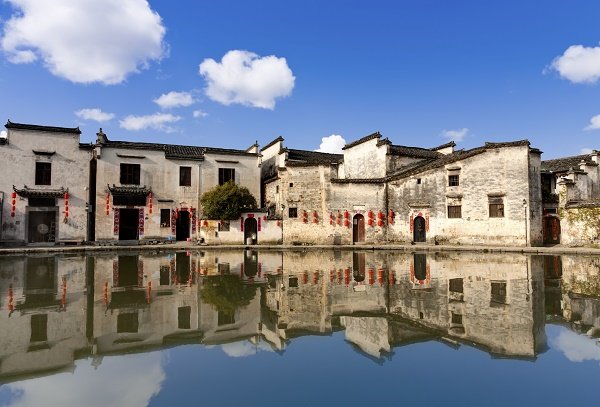
Beautifully preserved village of Hongcun near Huangshan
China has so much to offer the curious traveler that there’s simply no way to visit everywhere in just one trip. Most first time visitors cover the ‘must-see’ sites of Beijing, Xi’an, Shanghai and Guilin, but there’s so much more to discover and explore. Here we list our top places to visit on a second trip to China.
Huangshan
Our director Guy Rubin’s favorite destination in China is Huangshan – the Yellow Mountains. We recommend two days to enjoy the area fully – one day for exploring the mountain itself and one day for touring the picturesque villages that the area is also renowned for. Ascend the mountain top via a cable car, traversing the granite peaks and, depending on the weather, zipping in and out of swirls of mist. At the top one instantly appreciates the unique beauty of the mountain that has captivated artists and poets for centuries. Back down below, the beautiful villages around Huangshan offer a glimpse of a rural and somewhat idyllic China that is fast-disappearing. It’s hard not to fall for this area’s natural beauty and charming UNESCO heritage site villages.
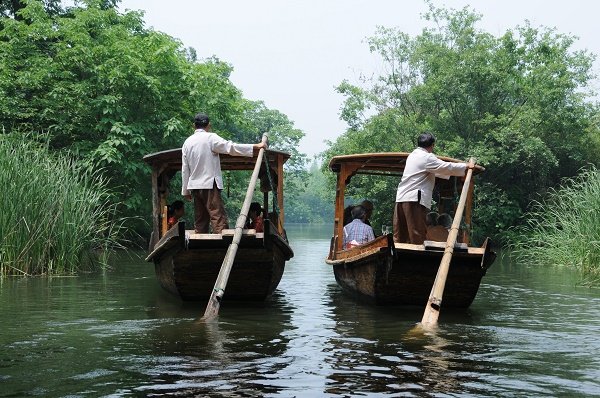
Taking a relaxing gondola ride on West Lake
Hangzhou
Only 2 hours from Shanghai and 3 hours from Huangshan is another China-highlight – the beautiful city of Hangzhou, which Marco Polo once proclaimed to be “by far the most glorious city in the world”. This city adjacent to the vast and serene West Lake is one in which to relax and explore Chinese culture and tradition. Enjoy a morning taichi lesson followed by a private gondola ride on West Lake to the accompaniment of your own private orchestra. The area surrounding Hangzhou is filled with Buddhist temples and peaceful tea plantations to explore during an afternoon. Hangzhou is also a great place to learn and appreciate the Chinese arts such as calligraphy or a tea ceremony.
Bronze masks at Sanxingdui
Chengdu
The city of Chengdu sometimes makes it on to people’s first time itinerary, and for good reason. Seeing and even holding pandas can be a highlight of your trip. There’s much more to Chengdu too – it’s a sophisticated and cosmopolitan city with great restaurants, shopping and nightlife and yet it still retains a very traditional character in its countless teahouses, temples and parks. Another nearby highlight is the archeological site of Sanxingdui, rivalling that of Xi’an’s Terracotta Warriors in historical importance. Take an afternoon to explore the spell-binding collection of bronze and gold masks and other jade and ivory artifacts dating from the 12th to 11th centuries BC.
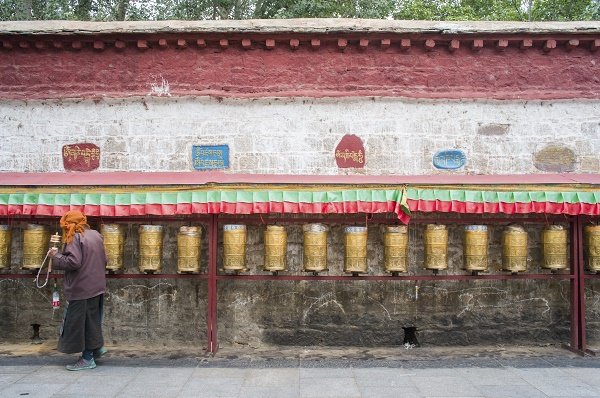
Spinning prayer wheels on the kora in Lhasa
Lhasa
If visiting Lhasa, Tibet we recommend a stay of 4 nights as there’s so much to see and this gives you time to acclimatize to the altitude. Most people therefore incorporate it into their second trip to China. The sights and atmosphere in Lhasa make it a truly special place to visit and another favorite of our director Guy Rubin. Visit the monasteries, temples and Potala Palace; witness the devotion of the pilgrims as you join them on the kora (pilgrimage); watch prayer flags fluttering in the wind against a backdrop of the mighty Himalayan peaks – it’s impossible not to be blown away by the splendor and raw beauty of Tibet.
To see a full itinerary incorporating Huangshan, Hangzhou, Chengdu and Lhasa click here. Other destinations we’d recommend exploring on a second visit to China are Lijiang, Shangri-La, Dunhuang and Pingyao / Datong. For advice on which destinations would suit you please contact us or one of our recommended travel agents.

Aman at the Summer Palace
What with so many luxury five star hotels in Beijing, travelers really are spoilt for choice in this megacity. But how do you choose when confronted with this much choice? It’s not easy, so we’re here to help and have written a brief guide to the primary choices for your luxury hotel needs in Beijing. The following are listed in alphabetical order.
Aman Summer Palace
The Aman in Beijing is an absolutely gorgeous Qing dynasty heritage boutique hotel. It’s located at the Summer Palace which is far from downtown Beijing but that’s actually the attraction. It’s a great place to go for some relaxation for a few days at the start or end of a trip. The rooms are all in a traditional courtyard style and the hotel grounds are peaceful and relaxing. To stay at the Aman Summer Palace is truly a unique experience which we’d suggest for you in addition to staying at one of the following downtown luxury hotels.
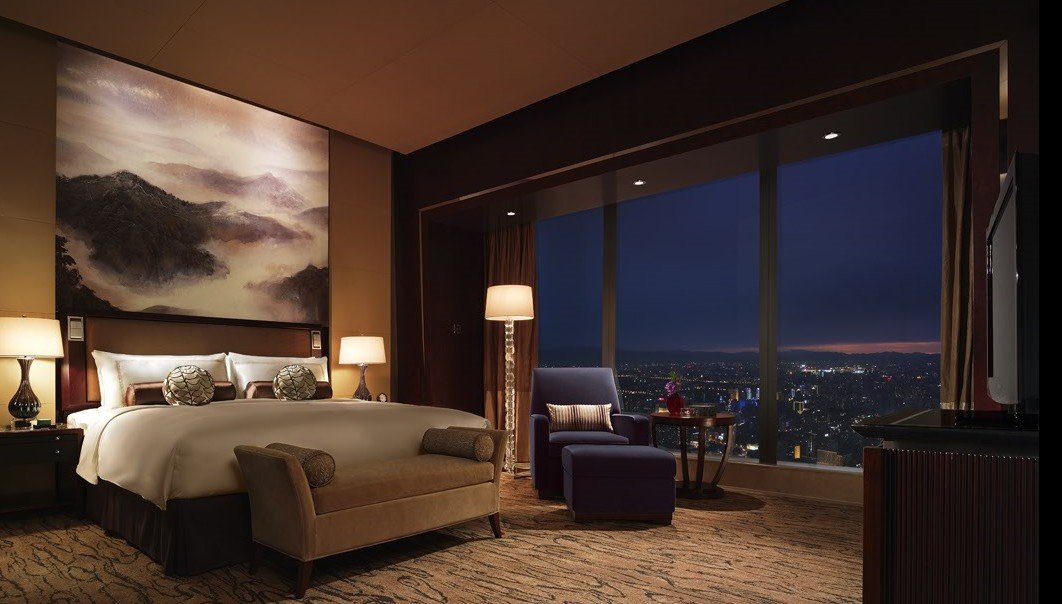
City views from a premier suite room at the China World Summit Wing
China World Summit Wing
Shangri-la’s China World Summit Wing (CWSW) has a great location right in the middle of Beijing’s Central Business District (CBD). However the real selling point here is that the hotel is located from floors 64 through 80 of the China World Trade Center building, the tallest and most prestigious skyscraper in Beijing. The views from the rooms, infinity pool, restaurants and bars are fantastic. You can see out over the Forbidden City and Tiananmen Square, and in the distance you can see Beijing is hemmed in by mountains to the north and west, it’s a stunning backdrop. The rooms are generous averaging 650 square feet. “Atmosphere” bar on the 80th floor is not to be missed!
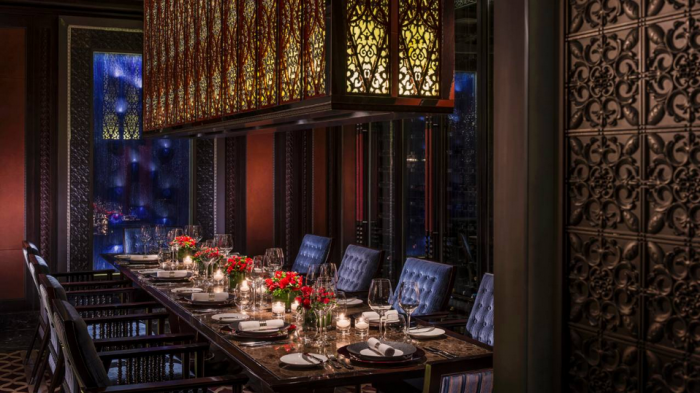
Mio at the Four Seasons
Four Seasons
The Four Seasons is a great choice for connoisseurs of luxury living in Beijing. The lobby often packed for high tea points to one of the highlights of this property, its fantastic service. This comes in addition to its spacious rooms and admired restaurants, particularly Mio, the Italian with its over-the-top chandeliers running the length of the restaurant. On the subject of food, this is the one hotel in Beijing to include many local Beijing breakfast foods within its sumptuous buffet spread. The location in the northern embassy district is great for politicians and leisure travelers alike.
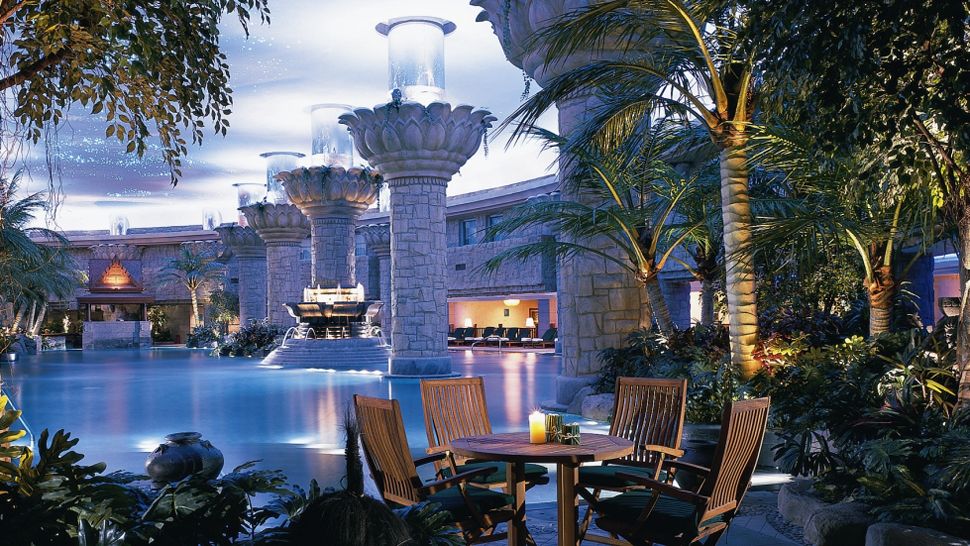
Bali-style underground swimming pool at the Grand Hyatt
Grand Hyatt
The Grand Hyatt is conveniently located on Chang An Jie, the city’s main artery, close to Wanfujing’s shopping areas, food night market as well as Tiananmen Square. By merit of its large number of rooms and location close to the city’s ministries, the hotel’s primary focus is corporate. However, thanks to its terrific Peking Duck restaurant, for many years one of the best in the city, and glorious 50 meter underground swimming pool, styled as a Bali beach, the property is versatile enough also to cater to visiting families. A hidden bonus is that some of its suites have views onto the Imperial Palace.
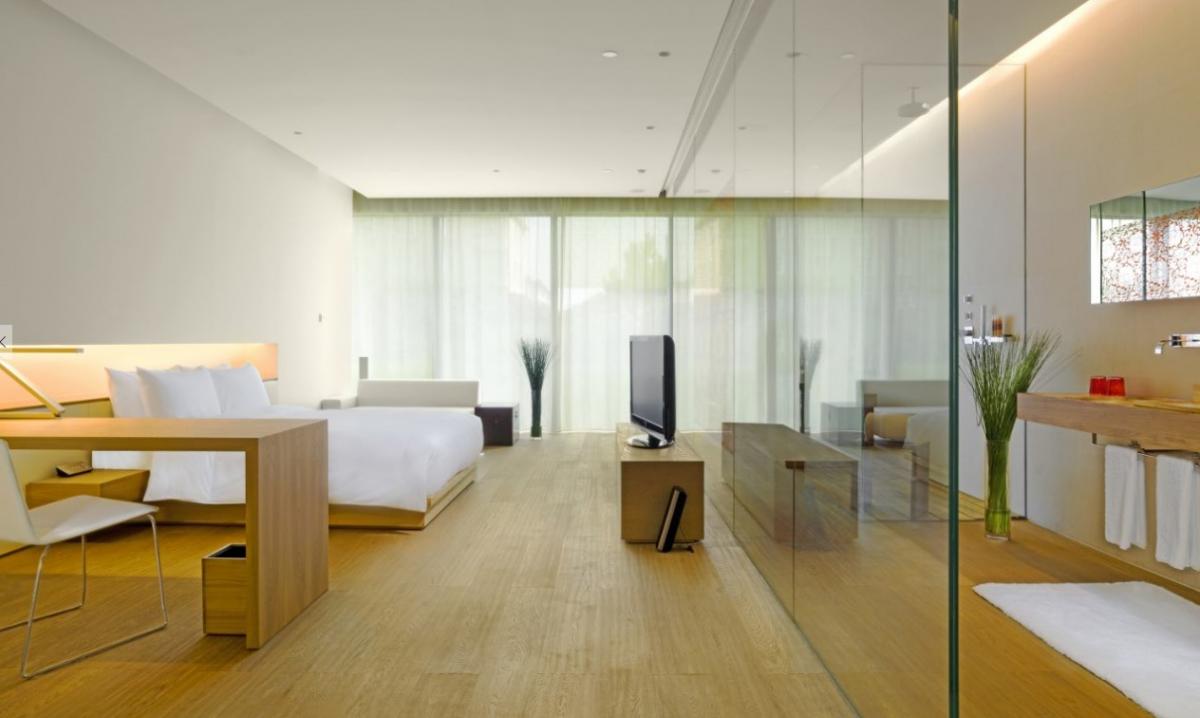
Unique Japanese design at The Opposite House
The Opposite House
The Opposite House has an enviable location right in the thick of all the action in Sanlitun – this is the place to go for dining, drinking and designer shopping. The hotel and rooms have a contemporary and fun design by Japanese architect Kengo Kuma and the lobby houses rotating art exhibitions. The bar and restaurants are also a draw – try Jing Yaa Tang for excellent Cantonese dim sum or Sureno for contemporary Italian cuisine. This is a sound choice for contemporary luxury in Beijing.

Lobby with a view at the Park Hyatt
Park Hyatt
With stylish bedrooms designed by Peter Remedio and public areas by Super Potato, there’s no doubting the pedigree of this property, housed in the Yintai Center, a skyscraper offering amazing city views from the heart of Beijing’s most prestigious business area only ten to fifteen minutes east of the Imperial Palace. Appealing by location particularly to the business traveler, the hotel still has plenty to offer. Over and above, “Xiu”, a lively bar and live music venue, and its “China Bar”, serving champagne and cocktails, “China Grill” was the first restaurant where Jack Aw Yeong, head of F&B for Park Hyatt in Asia, could experiment with his multi-cuisine restaurant concept serving Western, Chinese and Japanese foods simultaneously at the same table.
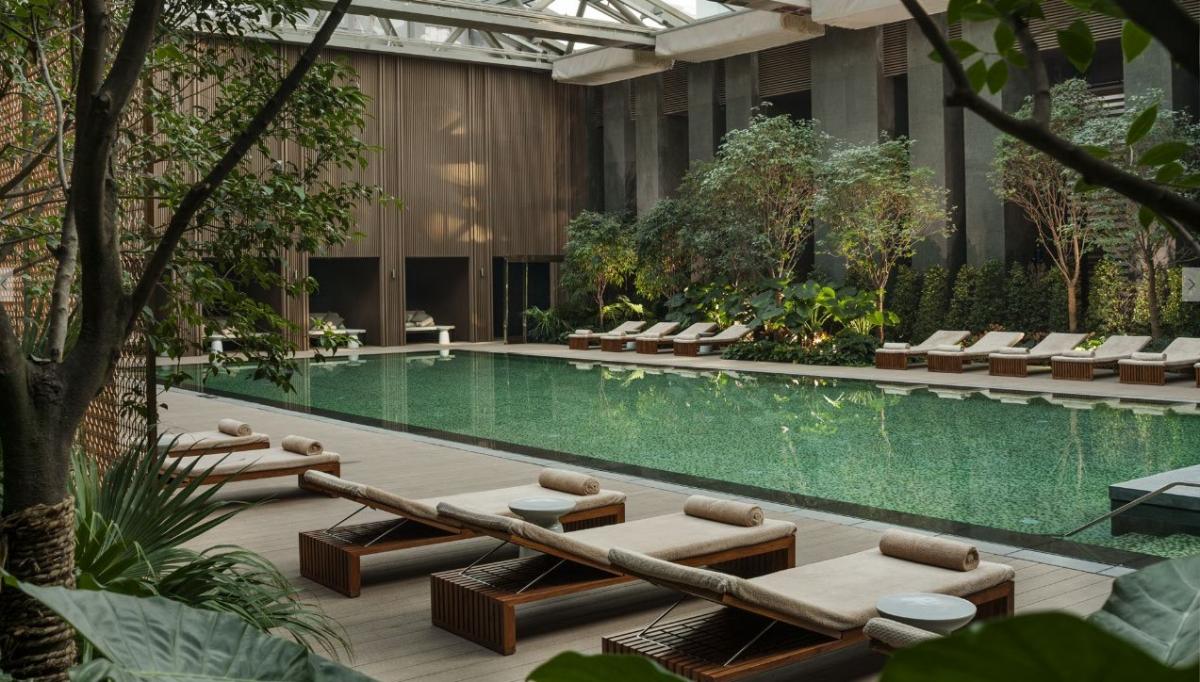
Swimming pool at the Rosewood
Rosewood
The Rosewood has only been open since last year but it’s quickly become one of the top choices for a luxury stay in Beijing. The lobby is gorgeous and all the rooms have a contemporary, classic feel. The location is great – right in the middle of the CBD. The swimming pool is a definite highlight as are the restaurants. We recommend Country Kitchen to experience northern Chinese cuisine and Red Bowl for trying Sichuanese hotpot.
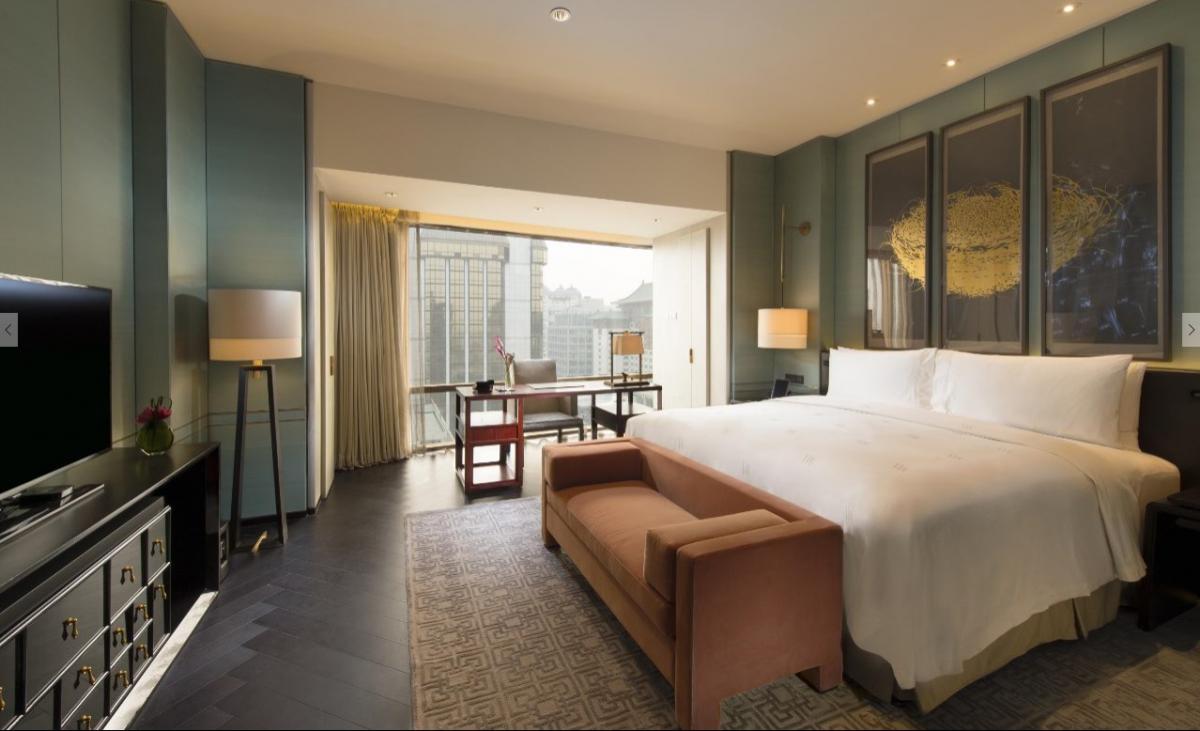
Beautiful deluxe king room at the Waldorf Astoria
Waldorf Astoria
The Walforf Astoria is another fabulous alternative. It boasts a fantastic central location within walking distance of historic sites such as the Forbidden City and Tiananmen Square, but also near the fashionable shopping and dining area of Wangfujing. The property has a lovely contemporary design with Asian accents and the rooms are beautiful. Moreover, the hotel offers courtyard suites and a private villa in a traditional Chinese hutong style in a separate low-rise behind the main building. The suites almost feel like an extension of the Aman Summer Palace, but in downtown Beijing.
To arrange a custom tour of Beijing with a stay at any of these luxury hotels please contact us or one of our recommended travel agents.

Luxury boutique hotel Alila comes to China, located in the bamboo forests of Anji
Imperial Tours has compiled another roundup of what’s happening and what’s new in China luxury travel this spring.
Art, Culture & Fashion
This month will unveil the opening of the first Shanghai store for home-grown fashion designer Ms Min. Up until now her gorgeous designs were only available online or in department stores like Lane Crawford. The new store is designed by Italian architect Vincenzo de Cottis and is housed in the Shanghai Centre.
Hong Kong’s Art Basel has now been and gone but there’s still plenty to see art wise in Hong Kong. One of Asia’s hottest artists, Shahzia Sikander from Pakistan, has her first solo show at the Asia Society Hong Kong Centre until early July. Meanwhile Galerie du Monde is exhibiting 25 works from The Fifth Moon group of Taiwanese artists, running from April 20 to June 01.
Running until May 28 at Pekin Fine Arts in Beijing’s Caochangdi is an exhibition by Hong Kong’s late Wesley Tongson. His modern take on Chinese ink landscape paintings are both beautiful and haunting.

Ms Min's designs are stylish and chic
Dining
There’s less news from the fine dining scene with only a few new places opening recently. If you’re in Shanghai and looking for a taste of something different then head to Alan Wong’s Shanghai at the Ritz Carlton. Alan is a celebrity chef from the US who specializes in Hawaiian regional cuisine, so if you love fish then you should definitely consider stopping by for a meal.
In Beijing The Georg is a wonderful new fine dining spot that actually opened quietly late last year. The restaurant is part of the Danish silverware and lifestyle brand by Georg Jensen and the food is a ‘Scandinavian take on international flavor driven cuisine’.
A touch of Danish class in Beijing at The Georg by Georg Jensen
Hotels
The St. Regis Macao opened just before the New Year on 17 December. They are the first property in Macao to offer a signature 24-hour Butler Service for every room and suite. In February the Grand Hyatt opened its doors in Chengdu, located in the same fashionable district as Swire’s Temple House.
Currently in soft opening phase is Ahn Luh Zhujiajiao, the first in a new chain of luxury hotels set to open in second-tier cities in China by the founder of Aman. It’s billed as an urban resort and is located in the water town of Zhujiajiao near Shanghai. We presume this chain will be aimed at the domestic market what with their spa being run by a Tai Chi expert and a focus on TCM (Traditional Chinese Medicine).
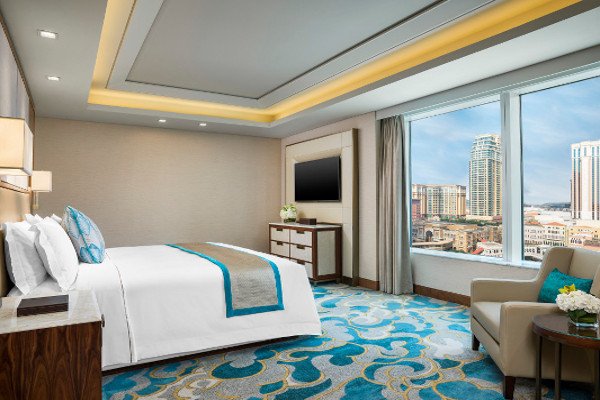
Recently opened St. Regis in Macao
Although this is now slated for a fall opening we are nonetheless already excited about the opening of the first Alila luxury boutique hotel in China. The setting will no doubt be stunning as the hotel will be situated next to a lake in the peaceful bamboo forests of Anji in Zhejiang province, where Crouching Tiger, Hidden Dragon was filmed (see top photo).
Finally, we are still waiting in anticipation for the opening of the Waldorf Astoria in Chengdu. The property was originally slated to open in 2016 but seems now to have been moved back to 2017. Likewise, no news yet on the opening date of the Four Seasons Tianjin which is due to open sometime this year.
We look forward to seeing what else is in store on the luxury scene in China through the year. In the meantime, check out our luxury China travel collection of photos here or to keep up with all the information on luxury happenings in China please like our Facebook page.

The Qiao Family Courtyard in Pingyao was the setting for the movie Raise the Red Lantern
One of the most composed and sublimely beautiful films to have come out of China is Raise the Red Lantern (1991), hailed by IMDb as one of the “25 movies you must see before you die”. For a quintessentially Chinese location, director Zhang Yimou picked Pingyao, a turtle-shaped, walled city of nearly 4,000 wonderfully preserved original Ming (1368-1644) and Qing Dynasty (1644-1911) buildings.
Almost the entire town consists of traditional cobbled streets dividing classically-styled courtyard homes, making it easy to picture Pingyao during its heyday as one of China’s premier banking centers. Money is the raison d’être of the 2,800 year-old city. Pingyao originally rose to fame as a trading center on the route along which the teas and silks of southern China were transported to Russia and beyond. Bustling trade prompted caravans of camels and mules carting great crates of bronze coins, an inconvenient security problem for the province’s famous financiers. Eventually one of the more enterprising devised a virtual payment system involving pieces of paper known as “drafts”. And with the opening of the Sunrise Prosperity Draft Bank (Rishengchang in Chinese) on Pingyao’s main street in 1823, the clearing process was born in China. Soon there were 22 draft banks, more than half the national total, with branches all over the country and overseas.
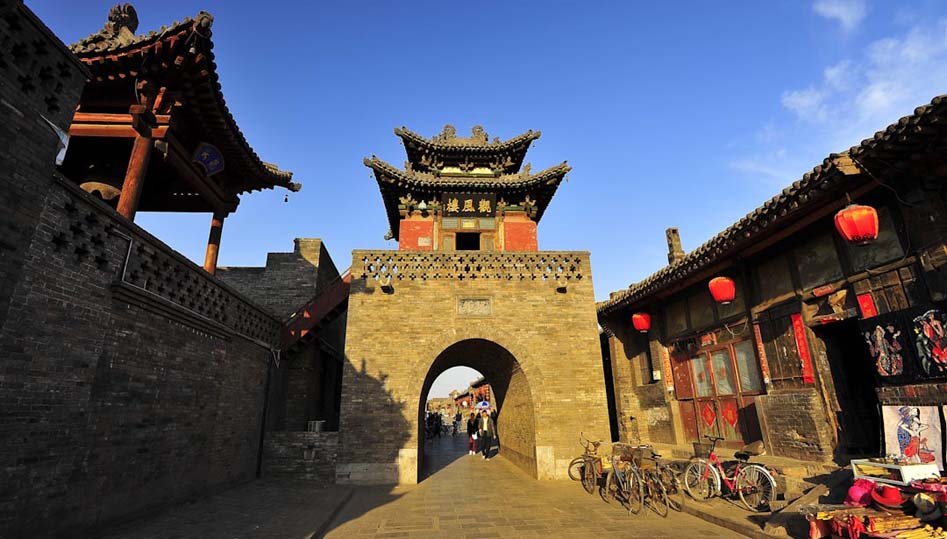
Pingyao's traditional cobbled streets and city gates are a major draw
Thus an already successful, fortified city built on trade metamorphosed into a spectacularly prosperous regional and national financial hub. Founded upon traditional Chinese principles the city centered on the City Tower with four main streets radiating outward in the four directions to the four-mile city wall. The positioning of its six gates — one in the north, one in the south, two each on the east and west walls – gave rise to Pingyao’s nickname “turtle city”.
More than 350 miles southwest of Beijing, Pingyao was probably too remote in recent times to succumb to the wrecking ball and modernizing China’s penchant for sleek skyscrapers. Its historic structures were cherished rather than obliterated – strict planning regulations came into force such that new buildings must conform to old techniques. Now a UNESCO World Heritage site, Pingyao is helping today’s China rediscover the value of preserving its ancient buildings – not least because there is so much money to be made.
Read more about Pingyao and its neighbouring attraction in Shanxi here.
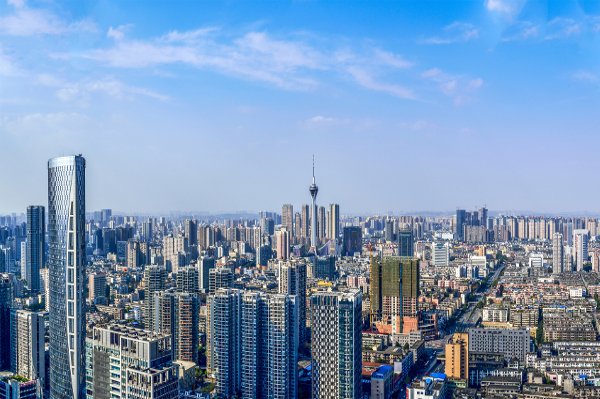
Chengdu city skyline – its population is 14 million and growing
Chengdu was recently ranked in the MasterCard Global City Index as the second fastest-growing destination in the world from 2009 to 2015. As of June 2015 there are 265 Fortune Global 500 companies in Chengdu and this number is growing rapidly. And all for good reason, as Chengdu is a great city with lots going for it. Of course the pandas are the prime draw but Chengdu also offers world renowned Sichuanese cuisine at fantastic dining venues, a range of superb new hotels with meeting facilities, great transport connections and a wealth of first class cultural attractions. Here we list just five of the many reasons Chengdu is a great place to visit, both for leisure and business.
Pandas at the Research Institute in Chengdu
1. Pandas: There are 3 places to see the lovable giant panda near Chengdu: the Panda Research Institute, which has the most pandas in the area; Panda Arc which is in nearby Dujiangyan, and is the only place where you can hold pandas; and Panda Valley, also in Dujiangyan.
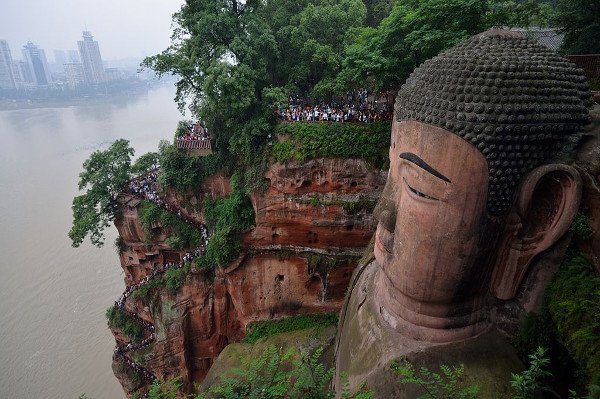
Giant Buddha of Leshan
2. Sights: Within Chengdu, the Qingyang Temple is a great place to absorb the local culture and learn about the Chinese philosophy of Taoism. Here you can practice Tai’chi, watch a Taoist orchestra or have your fortune told. Chengdu is also famous for its tea houses and performing arts. We suggest you combine the two by watching a private performance of face-changing or Sichuan opera in a local tea house. The area of Sichuan surrounding Chengdu holds many tourist attractions. A few hours’ drive south is the Giant Buddha statue in Leshan – carved out of a cliff face at the confluence of three rivers, it stands 233ft (71 meters) tall and is one of the largest in the world. The Leshan area along with the nearby Buddhist Emei Mountain temple area (also worth a visit if you have time), have been designated a UNESCO World Heritage Site. Last and by no means least, the archaeological find at Sanxingdui featuring three thousand year old gold-covered scepters and masks is second only to the Terracotta Warriors in China as an ancient wonder.
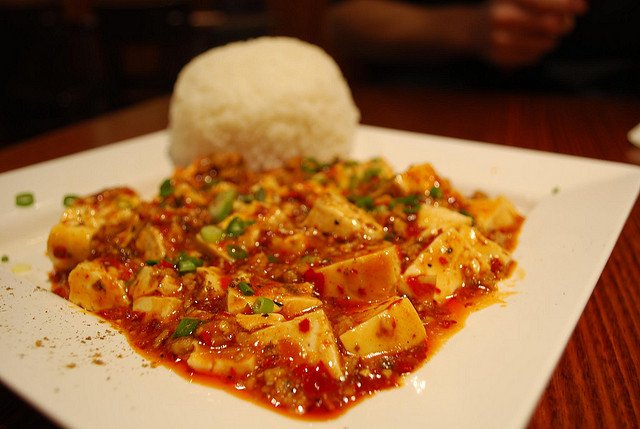
Mapo tofu, a famous Sichuan dish
3. Food: Chengdu, capital of Sichuan province, is of course home to the renowned Sichuanese school of cuisine and in 2010 became a UNESCO City of Gastronomy. Those with an interest can do a group culinary lesson with expert chefs. Alternatively, those who prefer simply to eat food rather than cook it can choose from many a fine restaurant serving up delectable Sichuan specialties. One dish you can’t leave Chengdu without trying is hotpot. We recommend Huangcheng Laoma for its authentic hotpot and traditional atmosphere. Another unique experience in local gastronomy is enjoying a private table at Chef Yu’s Family Kitchen. The sumptuous 32 course tasting menu will introduce you to both classic Sichuan dishes and Chef Yu’s signature creations such as an edible calligraphy brush. For another private kitchen experience there’s Ciguo which has 36 seats. You will be served a set course menu of local Sichuan dishes in a contemporary setting – but be warned, the food is especially spicy here!
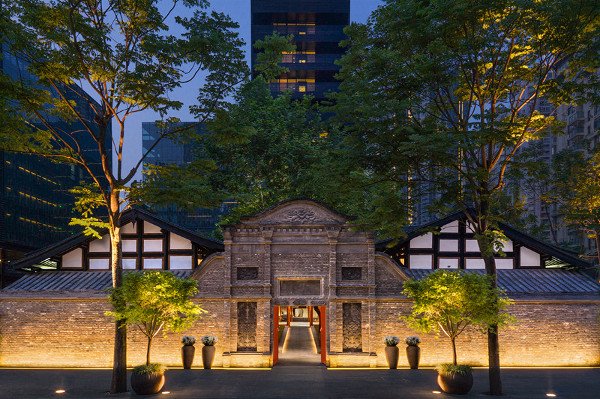
The Temple House Hotel
4. Hotels and venues: Many international hotel brands are represented in Chengdu including the St. Regis, Crowne Plaza, Intercontinental, Shangri-La and Sofitel, but we recommend The Temple House and Ritz-Carlton. The Temple House is newly opened by the Swire Group and is design-driven, blending modern and traditional Chinese elements seamlessly. The Ritz Carlton is luxurious with a modern business feel to it and offers excellent service. For meeting facilities, the hotels mentioned all have fantastic facilities. However to impress we’d once again recommend The Temple House. It has a subterranean ballroom for functions and it has meeting suites in beautiful hidden courtyards and heritage buildings.
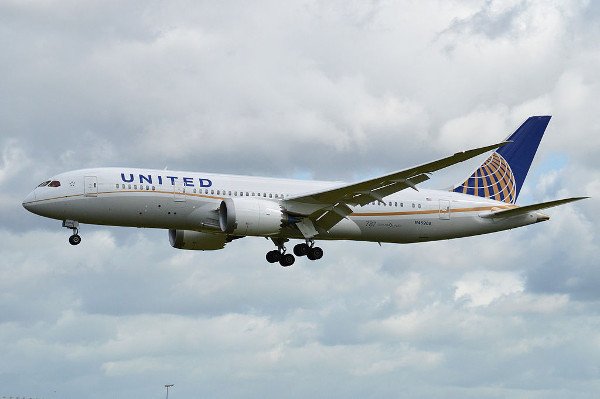
United Airlines flies direct to Chengdu on the new Boeing 787 Dreamliner
5. Transport: Getting to Chengdu has never been easier with direct air routes opening up all the time due to its role as a hub for western China. It now has more than 80 international air routes and has direct flights to the following cities: San Francisco (United Airlines and Air China), Vancouver (Sichuan Airlines), London (British Airways), Amsterdam (KLM), Frankfurt (Air China), Moscow (Sichuan Airlines), Abu Dhabi (Etihad) and Melbourne (Sichuan Airlines). A second Chengdu airport, twice the size of the existing airport, is currently under construction and scheduled to open in 2018.
If you’re interested in a bespoke luxury tour of Chengdu for business or leisure, please contact us at reservations@imperialtours.net
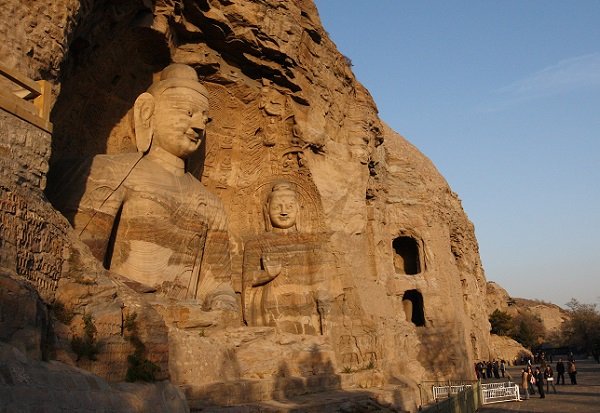
Giant Buddha carved out of rock at the Yungang Caves, Datong
Imperial Tours is very pleased to announce the addition of Pingyao and Datong to our luxury travel destinations. We recommend combining Pingyao and Datong into a 2 day luxury tour in between visiting Beijing and Xi’an. For anyone who wants to experience a journey back to ancient China at these two UNESCO World Heritage Sites, then visiting Pingyao and Datong is a must!
On day one we leave Beijing on an early morning flight bound for Datong, a short one-hour hop away, to visit one of the most remarkable Buddhist cave sites in China and the world. You will be amazed by 51,000 statues carved in the sandstone face of 252 grottoes that date from the fifth and sixth centuries. The Tuoba clan, a nomadic Mongolic people, conquered the kingdoms of northern China in the fourth century to establish their Northern Wei dynasty (386-534). To solidify their dominion, they co-opted Buddhism, then a fashionable and popular new religion. The impressive Yungang Caves are the expression of their official state creed.
Having enjoyed this rare cultural treasure, we head to the city for a bite to eat before a four hour drive south to the nineteenth century phenomenon that was Pingyao. Thanks to some innovative financial engineering, townsmen here founded a national remittance system that gave rise to its most prominent banking houses. At one time, the Rishengcheng Exchange House, the first and best known banking house, was responsible for half the silver trade in China!
That’s for tomorrow however. This evening, we arrive at Jing’s Residence, a boutique hotel in Pingyao designed by Antonio Ochoa-Piccardo, a well-known Venezuelan architect working in China for many years.

Gate at the ancient walled city of Pingyao
Although its history dates nearly three thousand years, Pingyao owes its international fame to its banking prowess in the nineteenth century, which lent a handsome uniformity to the orderly Ming dynasty design of its ancient town center. Thanks to the completeness of this town’s preservation, walking around its grid pattern streets it is easy to be transported to former times. The key institutions of an ancient functioning town can be visited and understood. For day two we have picked only a selection of the 300 sites and 4,000 ancient homes found here.
The town’s most significant structure is the Yamen administrative building, which formed the heart of the town’s government from the thirteenth to the nineteenth century providing social services as wide ranging as town law court to a medical care facility. We walk along a small portion of the 3.7 mile (6 km) city wall to the Rishengchang Exchange House. The City Temple is unusual in uniting for worship the Kitchen God, prized by farmers, with the City God, prized by various Emperors, with the Fortune God favored by all.
After lunch, we drive about an hour out of town to view Pingyao’s most famous site with its most unique. The austere family compound of the Qiao family provided the setting for Zhang Yimou’s world-renowned classic movie “Raise the Red Lantern” and is a much celebrated example of a Shanxi-style mansion. This is near the Shuanglin Temple, which houses an impressive collection of original statues dating from the tenth century. As the destructiveness of China’s history has caused the loss of most ancient temple statuary, it is a rare treat to be able to compare high-quality examples from the Song, Yuan, Ming and Qing dynasties.
The next day, after an early breakfast, you head to the train station to get on a 3 hour bullet train to Xi’an to continue your journey through China. If you are constrained by time, then you can also visit Pingyao by itself for a day between Beijing and Xi’an.
For more information on adding Pingyao and Datong into your luxury China itinerary please contact our Itinerary Designers by filling in this form or emailing reservations@imperialtours.net

Minsheng Art Museum in Beijing
Imperial Tours has compiled another roundup of what’s happening and what’s new in China luxury travel this fall.
Art & Culture
Fall is a busy time on the art scenes in China’s key cities. Beijing Design Week (Sep. 23rd to Oct. 7th) is running for a total of two weeks this year and they have expanded their number of installations and events across the city. Shanghai is hosting both the Shanghai Art Fair in November and the Art 021 Shanghai Contemporary Art Fair – both key events for buyers of contemporary art.
A new gallery has recently opened in Beijing up in the 798 art space in a converted electronics factory. Minsheng Art Museum is architecturally stunning but as it’s only recently opened the exhibitions are rather bare so we recommend going for the architecture rather than the art at this stage.
Visitors to Shanghai can now reflect on an interesting part of its global history whilst sipping coffee at the historic White Horse Café which recently re-opened in Shanghai’s Jewish quarter. The cafe was first opened in 1939 and quickly became a hub for Jewish refugees fleeing Nazi persecution. Shanghai has recently applied for the Jewish quarter to be recognized in the UNESCO Memory of the World register.
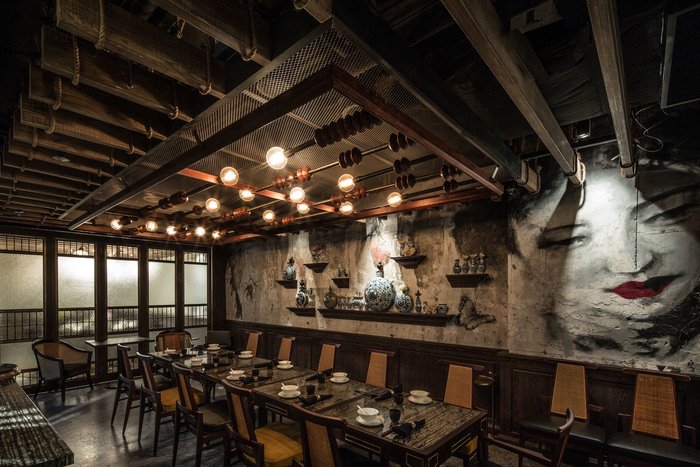
Award-winning interior of Mott 32 in Hong Kong
Dining
Beijing’s luxury fine dining establishment Temple Restaurant (TRB) has just opened a casual dining restaurant TRB Bites. We visited for dinner during their soft opening and can tell you it’s just as wonderful as you’d expect from the TRB team. It’s taken over the space that was The Courtyard by Brian McKenna, and for those not in the know that means a space overlooking the moat of the Forbidden City at its east gate – definitely a place to wow visitors to Beijing. You can choose from 3 to 5 courses from the menu and the quality and presentation of the food are almost on a par with TRB. Where it becomes more casual is that it sports an open kitchen and tables are much closer together meaning it feels less exclusive than TRB.
Speaking of Brian McKenna, he has also decided to go down the more casual eatery route with his new venue Molly Malone’s Gastropub and Grill at the Legendale hotel in Wangfujing. We haven’t tried it yet but expect British pub food with a gourmet, celebrity chef touch!
In Hong Kong Mott 32 has been serving up fine Chinese food for just over a year now but is definitely still worth a mention here. Our staff recently stopped by for dinner and were very impressed by both the food and the interior style. If it’s excellent dim sum you’re looking for then this restaurant delivers as all their dim sum is prepared on-site, unlike many other restaurants. The décor and design are very fitting given that it’s a contemporary Chinese restaurant beneath one of Hong Kong’s oldest banks. In fact, the restaurant was named World Interior of the Year in 2014 so it’s not only Imperial Tours that are impressed!
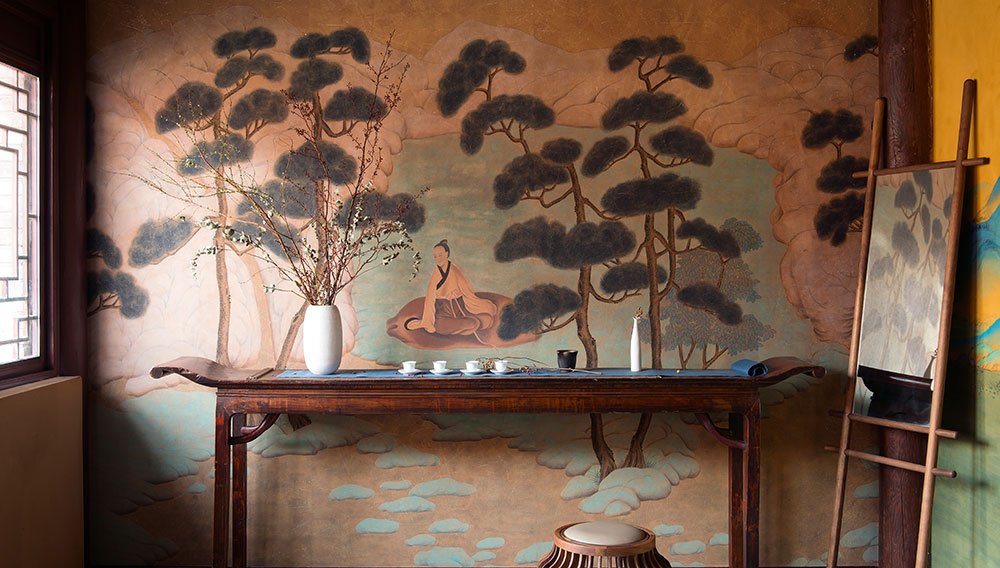
de Gournay wallpaper at the Beijing showroom
Luxury Hotels
One of the most talked about hotel openings in recent months has been The Temple House hotel in Chengdu, the third addition to the ‘House’ group of hotels by Swire. Chengdu is one of the fastest growing destinations for tourists in China and now ultra-luxury travelers are catered for with this chic new property. You can read our full review here.
In Beijing the NUO hotel has recently opened in the 798 art district. It’s the first of a Chinese chain of luxury hotels which has plans to go global. We have already tried and tested their restaurant which is excellent and makes a nice break from touring the many art galleries in the area.
Shopping & Fashion
de Gournay, famous for their exquisite hand painted wallpaper, have recently opened a showroom in Beijing. Located in a beautiful Chinese courtyard in the hutongs it’s their second store in China after Shanghai. If you are looking for something unique to take home then de Gournay’s Emperor Collection is currently on sale only in China, before a later worldwide release.
Top designers’ spring and summer collections will be on show for China Fashion Week in Beijing in late October. China Fashion Week is now well-established with sponsorship from Mercedes-Benz and is held twice a year to showcase all the in seasonal collections.
Finally in other news Imperial Tours has recently started an Instagram account so you can now get China travel inspiration on your phone as you go. Check out our luxury China travel collection of photos here or to keep up with all the information on luxury happenings in China then like our Facebook page.